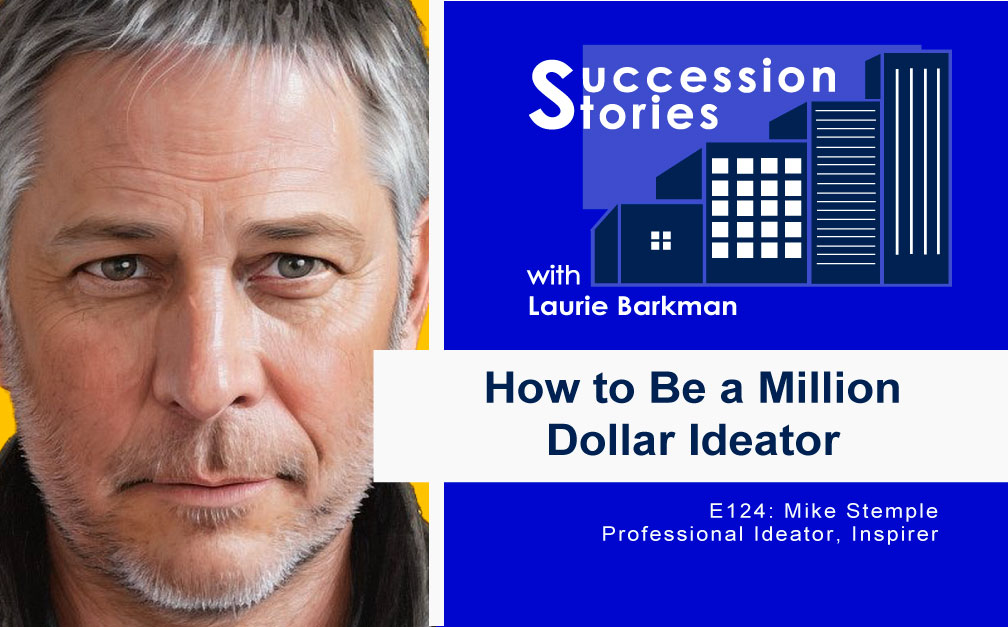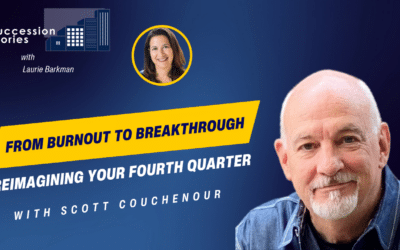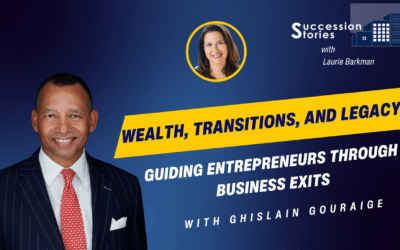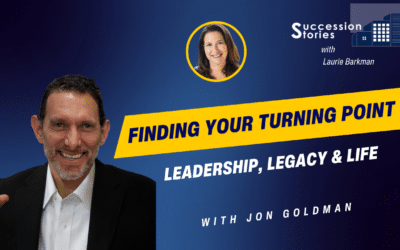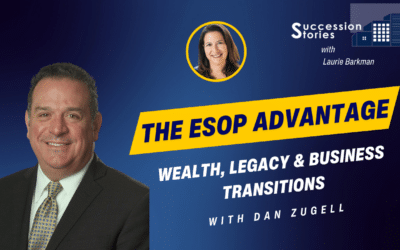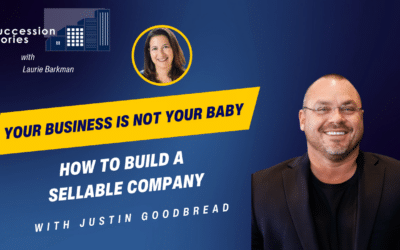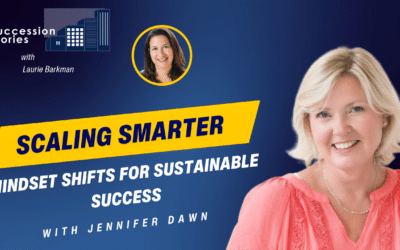For any business, regardless of size, innovation is an essential part of growth. We live in the age of entrepreneurs who are disrupting large companies more than the large companies are disrupting each other. Technologies like generative AI are enabling us to create value at a rapid pace. How do we explore new ideas that can drive radical value for your customer?
Succession Stories host, Laurie Barkman, talks with Mike Stemple, the Amazon best-selling author of two books, “Million Dollar Ideator: The Surprisingly Simple Way to Quickly Create Profitable Ideas” and “Innovating Innovation: Why Corporate Innovation Struggles in the Age of the Entrepreneur.” His ideas have created millions in revenue and helped millions of people.
Mike’s journey of creativity, curiosity, and innovation began with a life-altering event– an accident that ended one chapter of his life but opened another. He’s a successful entrepreneur who has built more than 20 companies and products including Skinit and 3M Original Wraps– those vinyl stickers you can put on tech devices like ear pods and phones.
Mike shares a unique story about Skinit that will inspire you. It’s a moving story that illustrates his belief that innovation is about solving problems for customers.
Enjoy this Succession Stories episode that just might inspire your next million dollar idea!
Listen in to learn more about:
- Rejuvenating innovation in mature companies
- A philosophical perspective on technology and innovation
- Building a business driven by innovation and problem-solving
- Have a radical love for the customer
- The 200-hour rule for shaping ideas and innovating
- Buy versus build approach to innovation
Show links:
- www.mikestemple.com
- Grab a copy of “The Business Transition Handbook” for yourself at https://amzn.to/3Hqj2eo
- Download the official workbook to help you plan your transition as you read at https://thebusinesstransitionhandbook.com
- Follow the Succession Stories YouTube Channel
If you enjoy Succession Stories, please leave a review. Reviews help me reach new listeners, grow the show and continue creating content you’ll enjoy.
Please click here to leave a review: RateThisPodcast.com/successionstories
About Succession Stories Podcast
Succession Stories is an award-winning podcast guiding entrepreneurs from transition to transaction. Hosted by Laurie Barkman, author of “The Business Transition Handbook: How to Avoid Transition Pitfalls and Create Valuable Exit Options.”
Learn more about Laurie’s strategic business transition planning and M&A advisory services by visiting: https://thebusinesstransitionsherpa.com
______________________________
SHOW SPONSOR: STONY HILL ADVISORS
Stony Hill Advisors works with owners like you to get ready and maximize value when you’re ready to sell.
Visit www.stonyhilladvisors.com/podcast for a complimentary business valuation.
Transcript
Laurie Barkman:
Mike Stemple, welcome to Succession Stories, this is going to be a very fun interview because it’s a discussion less than… more so a discussion than an interview and I love that you’re coming to the table with a ton of experience and working with mature large enterprises on innovation, so welcome.
Mike Stemple:
Thank you for having me. I’m really excited to do this podcast.
Laurie Barkman:
We’re gonna talk about many things related to innovation but I think the best place to start is your background. You have some superpowers when it comes to creativity and I thought you could share with me a little bit more about that. I think there was an accident that triggered some creativity in your life and I wanted you to share that with me.
Mike Stemple:
Sure. I’ll start at high school so I graduated high school and decided to join the army. I wanted to serve my country, very patriotic, growing up, and was a combat medic, did very well in the army so well that they kicked me out after two years and were paying for everything for me to go get my medical degree and so I came back to the civilian world and doing my undergraduate with an idea that I was going to be a doctor and going pre-med, in my senior year of college. In the fall, I was in a car that someone ran a stop sign, and my head got thrown against the doorframe of a truck and damaged my brain.
I got a traumatic brain injury. Not in the military, which is ironic. I got it in civilian life and in that instant, I lost both my military and my medical career, got pulled out of school, couldn’t function.
One of the side effects that happened is I damaged the front temporal right temporal area of my brain, I started becoming hyper-creative. It’s like I almost forgot all my education. All those times the teachers told me to stand in line suddenly see. Pay attention, stop imagining, Stop daydreaming. It’s like all that disappeared. All that training disappeared and I returned back to the state that I was in when I was five, became hyper-creative. Every single piece of paper around me that I saw, that was blank. I saw artwork on it so I started drawing like crazy and six months after that car accident, I had a new career. I was a very well-known sports artist, I painted these huge murals in Denver, Colorado, and the side of the highways for featuring like John Elway, Dikembe Mutombo of the Nuggets and Andrés Galarraga of the Rockies, and very, very quickly, within six months, I became one of the most visual recognized artists in my hometown of Colorado.
Laurie Barkman:
That’s an amazing, amazing story. I’m so glad you shared that it. It’s traumatic. Brain injuries are very, very serious and that you came away with a new skill, a new passion is just an amazing story. I could probably do a whole discussion with you on the artwork and maybe at the end of the show, you could share how people could confine some of your artwork so we’ll put a pin in that for now. Let’s talk about this creativity. Do you think that there’s something inherent in how your brain thinks to invent? You’ve invented a lot of different technologies. How did you enter that process? To share a little bit about problem-solving, what problems were you solving, and how did you come upon them? Share just a little bit about the technologies themselves. I think there’s a wide variety of the types of tech that you’ve invented over the years.
Mike Stemple:
Yeah. One I think every single human being on this planet has the power to be creative. Spend time with five-year-olds, and you will see creative geniuses running around like crazy. I think it’s innate within us, I think it’s built into our DNA, and then through our educational process that gets distilled down until we’re really really good operators, really good factory workers, really good obedient adults and so I come from the belief system that we’re all creative, that we all have within us the ability to create, and for me, it took a car accident, but I’ve also worked with tons of people, hundreds of people, where I didn’t take the car accident when it took is an identification of the mindset of a five-year-old, how do they see the world? How do they think of the world? Well, how do they consume the world, and what is that? What about that experience when we’re younger that we can tap into it as an adult?
One of the big ones is just question asking, just being curious. A lot of us stopped being curious. For me after my car accident, and I did art for a number of years, I got bored with it was kind of exhausting working with all these pro athletes to tell you the truth and so I switched very quickly in the late 90s. I learned to code and I started doing websites and I started asking a lot of questions. Technology to me is always a toolkit so whenever I see new technologies, like right now, the technology that’s in vogue is generative AI but I see all these not as definitive things, they’re just tools, so like paint brushes. To me, I am learning about the capabilities of technology is the easiest jumpstart to come up with ideas because when you understand, for example, how Bluetooth technology works, or Wi-Fi technology works all the sensors, the dozens of sensors that exist on the cell phone, it will understand the capabilities and you have that knowledge now, you’ve asked 1000 questions and kind of figured it out, it naturally creates a whole new set of questions is, how can I use this to change the world around me and so that leads into the philosophy side of ideation, which is, I see the world as incomplete.
My definition of innovation is the human response to evolution, so I think evolution is constantly happening, things are evolving and I don’t mean evolution in the Darwinian sense. I mean, evolution is the root of things change, everything’s constantly changing and how we respond to that, as humans is innovation. When you have this understanding of core technologies, and you start to see them as tools to build the next, the next next, as I call it, the philosophy piece comes in, where a lot of people accept the world as it is and I see the world as incomplete, so it’s frustrating. It’s a gift and a curse because everything I see around me is a version; V1, V2, but there’s a V3 or four or five that I can see as shadows behind it and I believe it is my responsibility as a human to create those new versions. We all have this capability, by the way, that the next is our responsibility. It is our desire, it is innate within us to create and so that’s the philosophy side of it so those two things come together the knowledge and the toolset and the curiosity and the question asking, combined with my belief system that we actually build the future, combined together and that’s how I’ve been able to do so much.
Laurie Barkman:
That’s so well articulated, I love that you talked about a philosophical view, so many technologists that I’ve met along the way. I’ve worked in startups, and I’ve worked in big companies that have tech teams, a lot of times they’re just looking to solve a particular problem, a very small problem, but not looking at the bigger picture problem. The other thing that resonated with me when you were sharing, it reminds me of my friend, Sean Ammirati. Sean was on the show, Episode 19, many, many moons ago, and he and I work together at Carnegie Mellon University. He’s Executive Director of the Corporate Startup Lab, which is all about corporate innovation, and Seann loves to say that entrepreneurs are seeing the world as it is today and thinking about what they can do to, as you said, to make it better to do that next, and they think about the way it ought to be.
You two are kindred spirits in that sense, so I wanted to mention that. That resonated with me a lot. When I when a high-potential startup who’s got two tech founders, let’s say, and they’ve got this wonderful tech, but they cannot articulate what problem is it solving, more often than not that firm is going to run out of funds, maybe they’ve got some series A or some seed funding, and they’re going to run out of funds. It’s the firms that really figure out what problem are we solving and who and who is it for and that leads us into this conversation about corporations and big companies and not startups, but how big companies innovate, and how they’ve lost their way on innovation. That’s really the crux of what I want to talk about today so I appreciate you sharing your background on innovations. And I do have your book in front of me, by the way, which is called innovating innovation and you listed out some career highlights, which is just incredible of the breadth of things you’ve worked on so I do want to acknowledge that you’ve built some technologies and companies, not everything worked out the way you would have expected it to. On your on your path to working with big companies in between was probably what 20 years of building and creating and exiting – however those exited – exiting startups exiting these technology applications and then you probably also did some of this work at BigCo. So can you talk about SmallCo and maybe some of the innovations along the way?
Mike Stemple:
Yeah, so I built 20 of my own startups over 20 I rounded to 20 and a lot of people are like, “Red flag. Why so many?” One of the things I do that my sorry other serial contemporaries of mine serial entrepreneurs don’t do is I recognize my failures. I’m not ashamed of them, I don’t hide them, I don’t push them away. They didn’t work. That doesn’t mean I don’t work. My startups are not me. That’s one of the big things I can coach new entrepreneurs about, is don’t personalize the thing you’re creating and make it all about you. It should always be about the radical love of the customer. You need to have a radical love of your customer and solve their problems. Use technologies to change their life and it can be one of my companies that was a big success was a company called Skinit. In 2004 I came up with the idea to personalize consumer electronics with easy-to-apply stickers, custom cut for them, and something in the grand scheme of things as trivial as that, making your phone look cool. I still had a radical love of the customer and what was interesting is with that company, I made all these different consumer electronic devices look cool, and the fan mail I would get about how meaningful my little simple invention was to some people, someone uploaded a photo of their new baby and put it on their phone and that’s what they showed everyone, I would get all these amazing fan emails or letters and I realized that my radical love of the customer, I invented a technology and created a whole system to manufacture these things at scale was impacting people’s lives in a positive way. I think that’s a problem that most big companies just don’t understand. I think they have a radical love, but it’s for shareholders and not customers and I think that’s why most big companies are failing to innovate at scale anymore, is they’re more concerned about radically loving their shareholders and giving them a return, than investing in their customers and radically loving them and creating technology that delights and makes them happy and makes their lives better. I think that’s one of the big unlocks I’ve had in my career. Going back to the failures, I keep track of them, and I post them I talk about them. I’m not ashamed of them. I think I’m batting at 40% success unless somebody scored it —
Laurie Barkman:
— which is very high, by the way. [Laughs]
Mike Stemple:
[Laughs] — which is pretty good. The more you do something, the more you learn.
Laurie Barkman:
When you say that, for a venture capital firm, if they get one out of 10 to hit a home run, that math works for them.
Mike Stemple:
Yeah, and one of the things I learned along the way is my 200-hour rule. When I come up with an idea, I usually come up with dozens of ideas, hundreds of ideas, and then I filter them based upon my own credible claim. On that idea do I have within me something, some secret sauce, some connection, some ability, some affection, some something on that particular idea to add value to it. For example, I created a company called Odojo, which ended up being a success. I only had it for six months, I sold it at the end of six months because it was solving the problem of keeping kids safe online on social media at the advent of social media and the problem is I don’t have kids so I created an amazing technology that was able to keep kids safe, and help parents understand what was happening but when I was going out to sell it, I had no credible claim because I couldn’t point to my own kids using it and so that’s why now I have this 200 Hour Rule. I have to have a credible claim on the ideas I worked on and I start the clock and then I have 200 hours, I have 200 hours to make significant traction on the idea and every idea is a little bit different. Significant traction within 200 hours is showing a pitch deck to somebody about the idea and then wanting to participate whether it’s an investment or be a customer or join it or make introductions, or partner there has to be a significant amount of that, and then 200 hours I have a timer for all my projects at the top of my computer into 200 hours if there’s not significant traction, I kill it. I name everything, create companies around everything because I always try to project success out of the gates trying to manifest success, but at the end of 200 hours it’s not worth my time to pursue work on something hoping that some way somehow something magical is going to happen along the way that make it a success. I believe I create the future if I can’t create something of value within 200 hours I move on to the next idea.
Laurie Barkman:
You know there’s a beautiful story in your book about Skinit and when you were in a restaurant, can you share that story?
Mike Stemple:
Sure. One of the things I always try to tell new entrepreneurs or even people in corporate careers is identify the moments in your life that made you emote, to really hit you hard and really define that and really create the story around it. Really identify it, write it down because that story will be worth a lot in the future to other people. It helps other people understand better and that’s the story I think you’re talking about. This is year two Skinit worked all day, got done, went to the place called Tokyo Joe’s fast food restaurant. Going through the line and in front of me was a mom and her kid, a young kid, first day of kindergarten, and he’s bawling his eyes out and talking about how he hated school, the kids were picking on him. He never wants to go back. He was just really, really upset and I could tell the mom was just completely out of her element. She did not know what to say. There was nothing she could say to calm him down and he was very upset and as I watched that child, it affected me.
My nickname at that time was Willy Wonka of the West, I just stayed in my factory creating amazing things, so it was very–and I’m very introverted–so it was very typical what I did next. They went and sat down. I went up to them. I took out my business card, I knelt down next to their table and handed the business card to the lady and I was like, “I couldn’t help hearing what was going on, and I think I can help,” and so she looked at me like I was crazy, but I think she was at wit’s end so she gave me some runway and I took out my phone and had a US Army sticker on the back of it. I showed it to the boy and I told him, “I own a sticker factory, and I make magic stickers, and I would love to make some stickers for you,” and his eyes got really big and he looks at his mom, looks back at me, and he was just like, “Really,” and I was like, “Yes if your mom will write down your address, I will send you some stickers,” and she took a leap of faith with me that day. On the back of my business card, she wrote down her address, handed it back to me, and I told the kid, “I’m gonna go to my factory right now and make you some stickers.” o Went back to the office, left them, I sat down, everyone had gone home, so it was just me. It was a magical night. designed a series I think I made like 20-30 stickers, all the pro sports teams in Denver, anything I thought, a young six-year-old boy would want, put them in envelopes, sent them off. Didn’t think twice about it, put my business card in there that she had written the address down, did it, checked out, done, and I forgot about it so busy running a startup and I thought I was doing a nice thing.
The following Monday I get a phone call. No following Tuesday, I get a phone call and she’s it was her. She called me. She says. “Is this Mike Stemple?” “Oh, yes.” She goes, “I don’t even know if you remember me but you made some stickers for my son,” and I was like, “Oh, yeah, how do you how did you like them?” And she said, “You have no idea what you’ve done.” This day that makes me tear up because hearing that my natural instinct is I did something wrong and I said, “What happened?” And she told me the amazing story. She goes, “He went out to the mailbox the next day, the stickers weren’t there, went out the next day and they were and he was so excited, it was Saturday and we took them out. We laid them all out and I finally understood what you meant by magical stickers and we pros and cons on all of them of which one he wanted to put on and then he asked me can you do show and tell?” And she was like taken aback like, “Here’s my son who is being bullied at school wants to stand up in front of his class and show his magical stickers,” and so she wrote a note, did it. Went to school on Monday and she went to go pick them up on Monday and she couldn’t find them. He wasn’t at the curb and she was all upset because over the previous few days that he was in school every day, he was right up the curb as quickly as possible trying to get them to the car and he wasn’t there. She parked. Gets out. She’s looking everywhere, and a panic and she finally hears us laugh so she’s telling me this, I’m sitting on the phone like, “Oh my god, what is this going to happen? What’s what’s going on here?”
She told me that she heard his laugh and she stepped to the side and she saw him talking to a group of guys, friends, new friends, and he looked just like a normal kid. Eventually he saw her, grabbed the kid and he ran over to her and he introduces his new best friend and the best friend tells the mother, “Your son’s so cool. I wish I had diabetes too,” and that was the amazing thing about the stickers. The kid was bullied because he had an insulin pump. He had to wear an insulin pump, a Medtronic insulin pump and that’s the one reason he was being bullied; he was different and when I knelt down at that table, I looked at the Medtronic insulin pump on his hip and I tried to remember every detail because I had to go back and create stickers to custom fit him and I nailed it on my first try. I have no idea that divine intervention on that one and what I did is I helped that kid by those stickers mask his disability, and something cool. I don’t even know what he probably chose Denver Broncos, masked it, and made his disability something he could talk about and that’s one of the things I think a lot about, I talk to a lot of product companies, I work with a lot of product companies is those moments are you innovating to create those moments, a simple sticker company transformed young boy’s life. I think that’s really cool.
Laurie Barkman:
Thank you. Thank you for sharing that story. It is amazing. It’s moving and I think it does illustrate the point of the power of an entrepreneur, to connect and to try to solve a problem. That particular problem wasn’t what you set out to solve with this innovation, Skinit but it had an amazing radical love, and the connection we’ll be living on forever. As companies get bigger in their corporate lifecycle, from startup to adolescent to adult, the corporate lifecycle sometimes can take us in the other direction, where there’s a decline and a fall and it is possible for companies to come back from that other side, the Death Valley, but it’s difficult. As companies go from gen one, to gen two to gen three to eventually this large, mature company that’s been around a long time generations, they get further and further away from their entrepreneurial roots and it becomes a challenge. It becomes more internal, right, it becomes about solving things that maybe the customer doesn’t care about, or we’re so far away from the customer, which is why I’m passionate about this topic about corporate innovation, and what mature companies can do to get back to those entrepreneurial roots, so let’s talk about how you’ve helped some of those big companies do that with a corporate innovation process? How have you seen this working or not working in big companies?
Mike Stemple:
That’s a good question. First, I probably should tell about my transition into being in the corporate realm. After building enough companies and mentoring and all these incubators and tech startups and stuff, corporate executives started noticing about a decade ago that they were losing an accelerating market share to startups, startups were going from zero to unicorn in a very fast trajectory and that’s getting faster and faster. You look at the generative AI companies, it’s almost overnight and so they’re being disrupted, their businesses are being disrupted the margins, then Pepsi and Coke aren’t competing against each other anymore. They’re competing against the 1000s of young startups out there, and they’re stealing an advancing market share.
Corporate executives realized there’s something magical going on. It’s not a trend. It’s not a fad, Accenture and all the big five consulting firms were wrong, that the age of the entrepreneur is here, and it’s here to stay and it actually has all the advantages over the corporate and so they started reaching out to people and luckily, all the companies I have worked on my sales process, would I build technology like Skinit and then I would partner with another larger entity that had customers, and I would white label it with their brand ao like HP and Dell were two of my big customers that Skinit when they would market laptop skins to all their customers.
I didn’t have to have a big sales organization and in doing that, I worked with all these corporate innovation people and all these large companies, carriers, hardware companies, and brands like Disney. I’ve worked with a ton of innovation people over the year in the corporate realm so it was natural, they would reach out to me and say, “Hey, can you come in and talk to us about what it means to be an entrepreneur and kind of what you think and how you act,” and so the tagline for my company is ‘I help executives, corporate executives, think and act more entrepreneurial’, so I get pulled in and, day one, I have to like start changing how they actually their psychology of how they think about their business. Because like you said, they think about it in a very operator, way they operate the machine of the business and they have this word called enough. It’s good enough. I hear enough a lot in corporate rounds like this is good enough. Or this innovation solves this problem enough. It’s like a limiter that’s a stop of where they’re comfortable in it. Fear begins, they don’t want to journey into that fear and in the startup realm, nothing is enough. We live in a land of we can we invent the future, we can create anything. We can change anything, we can disrupt and there are no rules we’re not, we don’t create rules in the startup from the self limit us. In fact, I argue there’s no, there’s, there’s definitely no rules. There’s some laws, but even laws are up for negotiation, as Airbnb and Uber have pushed against those and so startups push against things and corporate doesn’t. They stay within a very defined, comfortable, manageable, non fear-inducing innovation bubble. But unfortunately, all the advantages that they once had; plentiful capital, plenty of time, top talent, access to expensive infrastructure and technologies, that’s all been democratized. They no longer have that. It’s available to me as a startup, I can have an idea of the day and be in production in a week and so they don’t have the advantage anymore that they have, all they have is a legacy brand, a lot of data and a lot of insight and a lot of relationships, and that’s it, and it’s easy to whittle away all those over time, so I think that’s the big difference between startups and corporate is startups aren’t playing by a set of self-imposed rules of limitation and big companies are.
Laurie Barkman:
There’s different types of innovation out there. If someone’s thinking about innovation, they might think, “Oh, it has to be a disruptive technology,” something that’s completely different. It’s a whole new—when the airplane was invented, right? It’s completely changed. Travel is one disruptive technology example and then there’s incremental innovation, which helps us improve our products and services in an incremental way. Like whenever you get a new app, or update on your phone, that’s an incremental innovation, because it’s helping to move the product or service forward, and then there’s other categories of innovation when you’re working with a big company, and they’re saying, “Hey, we want to, we want to do better. We want to innovate, we either need a process, or we need to jumpstart our creativity internally.” Let’s let loose on the word enough. How do we stop ourselves from saying it’s enough? How do we think more broadly, as you reflect on the different types of projects that you’ve done with big companies, where you are the innovation consultant, we can use that title? Or an innovation advisor? What types of things are you seeing as the problems like why are they bringing you in?
Mike Stemple:
The biggest reason I’m brought in is because what they’re doing isn’t working anymore. Existing way of innovating no longer launches a product at the end of it that’s competitive. It’s late. It’s always late now, big companies are always late to the market. Can you get to take the outliers out of the picture? Yeah, you got to take the Googles, the Facebooks, the Apples, the Amazons, you got to take those companies because they’re really good, large, innovative companies. You got to take the fashion brands or the consumer packaged goods companies, by the time they come up with something new, and go through their just insane process of approvals and get into the market, they’ve already missed a trend and so they’ve already given away their customer, their historically earned customer, they gave them to a startup for free, because they couldn’t respond with a good product to the startup. Startup saw trend, so new things, a new way, even an incremental, small, lovely like in the beverage space. Small little changes have big, big ramifications, as all these larger entities always think that they’re going to be able to launch and because they have scale, and they have connections, and they have distribution, that it matters. No, it doesn’t matter anymore. It’s irrelevant. If that is your defensible position, you’ve already lost the innovation game so what a lot of big companies do now is they’re trying to change their thought around. Maybe we shouldn’t innovate on disruptive stuff internally. Maybe we should just acquire startups that are disrupting things. We see that definitely in the consumer packaged goods space.
Laurie Barkman:
Build versus buy, how long will it take us to do it? What’s gonna cost us to do it and what are the alternatives?
Mike Stemple:
I’m a big fan of that because as an entrepreneur, I create something—and this is one of the big things I have to coach new entrepreneurs—when you create something, “why?” It’s I get it to change the world. radical love of the customer, but your journey is tied to that, what is your exit of that? When do you get to leave? You’re not going to run it forever. In fact, I actually argue that most innovators should not operate their own businesses. When do you leave when you get your big payout? Everyone has these fantasies that they’re going to build a sustainable long-term company but it’s really, really hard to do that with large multinational conglomerates that just have efficiencies at that level. It’s hard to compete against this, why we see so many startups being acquired by especially in the consumer packaged goods space, or the beverage space, so many startups are being acquired, is it the founder or the business wants to get paid, have an outsized exit, and move on to something new, and the business gets a valuable intellectual property piece that they can roll in and probably kill and just over process, over manage, over operate and it’ll just disappear into oblivion – but that’s me being jaded.
Laurie Barkman:
Was that your experience with your companies that you were building to sell? That you had an idea, and you reverse engineered, so to speak, like you, you’ve thought ahead on who if I build this technology, or this product or this service, who might it fit, and what problem is it solving for them?
Mike Stemple:
Yeah, I think, on any new thing you begin like being an entrepreneur, when I first became an entrepreneur, there’s the romance phase, where you’re changing the world, radical love of the customer, and trying to make a difference and then eventually, you start to realize, alright, “I only have so many years of productivity in my life, I kind of want to retire one day,” I kind of start thinking about the financial aspect of this, so after 20 companies, I think very, very specifically about intellectual property creation, as wealth creation and my own wealth creation and that’s one of the reasons why I have the 200-hour rule is, I know exactly how much that cost me in time, I know exactly how much that time is worth. I’m willing to make that bet but I’m not willing to spend $1 more than that and that has been informed by working with corporations who look at acquiring things that are very intellectual property, wealth creation metrics and so that’s one of the nice things and I’m doing this right now with my book. My first book was the one you have a copy of, Innovating Innovation, it was my altruistic book. This is my book to help corporate executives figure out innovation. My next book Million Dollar Ideator is more about wealth creation. It’s about how do you come up with million dollar ideas, because I believe that if you can’t ideate you’ll be working for someone who can so if you’re not a great Ideator, you’re at the mercy of those who create ideas and I think coming up with a great million dollar idea, whether you’re in a job, or you’re an entrepreneur, or in any aspect of life, is the only route to true independent wealth.
Laurie Barkman:
For sure, and it’s good advice. I talked to students who are pursuing entrepreneurship, either because it’s a degree in entrepreneurship, or getting their MBA or undergrad or they’re tech students, actually just so timely, this conversation, I’m going tomorrow to campus at Carnegie Mellon to do this talk about different types of entrepreneurship and different ways to think about not only like you’re saying, what are they passionate about? What do they enjoy, but where might it lead them? It isn’t always about invention. There are other ways to be an entrepreneur, one of which is to be a corporate intrapreneur if we can use the word, and finding your path within a company but if you want to, if you want to become that million-dollar Ideator, then yeah, how do you find that big idea, and it’s really exciting. You’ve got so much great experience. I know, it’s hard to boil it down to just a few things but if a mature company wants to think about innovation, especially as we’re heading into a recessionary time, and maybe they’re saying, “Oh, it’s belt-tightening time, I can’t be investing in innovation,” what are those two to three reasons why you’d say, “Oh, that’s wrong, you need to continue investing. These are the benefits. These are things to think about.”
Mike Stemple:
I would tell them to look historically. It’s not by chance when we go into tough times that radical new technologies are launched right at the beginning of tough times. The iPhone kind of came out right before the last recession and generative AI and robotics and a lot of really interesting tech is being launched right now and startups are going crazy. I counsel large companies that–I’ll use generative AI as an example. There’s a lot of hucksters, there’s a lot of scammers. It’s the next crypto, there’s just a lot of noise being generated around it, but the core technologies are fascinating and the core technologies are disruptive. They will have a huge impact in ways that we don’t even know yet. Entrepreneurs haven’t invented all the cool ways that we can use these new technologies, this new power to paint brushes to create the next next, if you ignore it, if you don’t have people within your business coming up with the interesting ideas, at least creating the patents, least creating the the the ideas that are worth billions, internally and securing that intellectual property, then you’re going to be at the mercy of a whole new host of startups because it has never been easier to build a startup and we might be in a downturn with startup funding right now and that has more because of market conditions, but there has never been as much money sitting on the sidelines ready to invest in the next group of startups, ever. I mean, it is a massive amount of capital ready to be deployed and if you’re a big business, and you don’t recognize that, then you will be acquiring your next round of products at a premium versus building them in-house with talented people that you already have on staff.
That’s the advice I give them and then usually they want to understand more like why aren’t they doing it now? Why aren’t we making this difference now? I say, “Well, because your psychology of your business is wrong for innovators. You got to let them actually do what you want them to do. You got to allow them to be curious,” and curiosity is the one I always point to right now. Because curiosity in a large business in this economic environment is being clamped down, pushed out, penalized. If you’re curious right now, it’s attacks, “Stop being curious,” and I’ve heard that. “Stop trying to figure out how to make things better, we need to stop spending money,” and I think that’s the wrong move right now because everyone I know that is a talented entrepreneur is working on amazingly cool stuff and they’re gonna get start getting funding later this year into next year and it’s just gonna be this whole new renaissance of cool startups, just like in early 2010 2011 2012, when Uber, Airbnb, all these really cool things came out, I think we’re gonna see a whole new renaissance of tech startups coming out over the next four or five years, and if big businesses wanted more, that’s fine. That’s why there’s the term disruption. Disruption doesn’t just happen. My definition of innovation is the human response to evolution. If you ignore evolution, if you ignore the ever, the evolving of things around you long enough, that wall eventually collapses onto you and that’s what’s called disruption.
Laurie Barkman:
Yeah, for sure. There are so many things that you shared today that I think people will really value and maybe want to listen to this episode again and over and over, it’s very inspiring and some of the key messages, just to reiterate, is we can’t just sit back on our laurels. We can’t just let things happen. Whether a big company, we’re a small company, privately held corporations, things are changing and evolving, and if we don’t participate in that process, we’re going to be left behind. It’s also a wonderful message to stay close to the customer, be passionate about what problems you can solve for them, and the story you shared about the young boy is, of course, a very individual story, but if we take that to the bigger picture, it’s about listening to your customers. It’s about understanding what they care about, and how do you solve their pain points, and ultimately finding that ROI, right? If it’s build versus buy, that’s, we’re driving to make the world a better place but we’re also trying to, we do want to create value for our companies. For our listeners who know this show for a long time, a couple years now, we’ve been doing the show, and the pillars of this show are innovation, growth, and transition, and if you think about it, in that context, you’ve hit on all three, which is, you’re you as the owner, as the tech innovator, this is not your baby, that it’s your identity, but you’ve created something, you’ve put good in the world and that’s a special thing. But it’s not you if it lives or dies, right? You don’t live or die with a company and so separating from it at one day. Thinking about it at that earlier stage is a good thing and I advocate for that that in and of itself creates value and thinking about that exit and so all these themes together in the show was very, very powerful, so thank you so so much for coming on and sharing your insights with us. If people want to get in touch with you, what’s a great way for them to do that?
Mike Stemple:
Mikestemple.com, everything else links out from there. Everything I’m working on all the companies, I’m involved in all my new nonprofit stuff going up there as well. All my books are up there, too.
Laurie Barkman:
Awesome, awesome. As I asked all my guests, if they have a favorite quote, something that inspires you for leadership or entrepreneurship, what’s something that you’d like to share with me?
Mike Stemple:
It’s my own quote. I know it’s kind of self-serving, but I love this. I remember the day I came up with it. It goes like this, “Inspiration leads to hope. Hope leads to courage and courage replaces fear.” Seek inspiration out every single day, and that will give you hope. When you have enough hope that actually feeds into this thing called courage. You can’t be courageous without hope and when you have courage, doing crazy things just becomes easier. You’re actually in the mind. They’ve done scientific studies that show that courage and fear, occupy the same part of our brain and it’s like a glass when you put courage in, fear comes out and so the more courage you can have, the less fear your experience and I think that’s a big thing going into this next economic season we’re going into is, don’t go into it afraid there will be an end, this too shall pass, believe that you create the future and you will come out stronger on the other side.
Laurie Barkman:
Thank you so much, Mike, for being with me today. I really appreciate you being here.
Mike Stemple:
Of course, I had a good time. Thank you for having me.
Laurie Barkman:
To our listeners, thank you so much for your support. Catch Succession Stories on your favorite podcast player or YouTube. If you want to maximize the value of your business and plan for future transition, reach out to me for a complimentary assessment at meetlauriebarkman.com. Join me next time for more insights from transition to transaction. Until then…here’s to your success.

